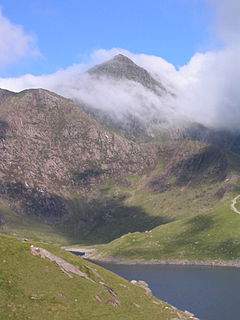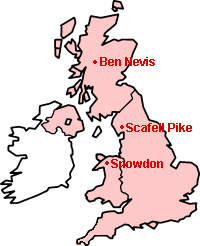National Three Peaks Challenge
The National Three Peaks Challenge ( "National Three Summit Challenge" ) is an individual endurance testing in the UK , in which participants climb the highest mountains of the three countries England, Scotland and Wales. It is also commonly referred to as the Three Peaks Challenge or Three Peaks and is not to be confused with the Yorkshire Three Peaks Challenge.
Although there are no fixed "official" rules, only completing it within 24 hours or during a weekend is generally recognized as a success, which makes the use of motorized transport essential. Some participants start and finish the challenge at sea level, while the majority place the start and end point at the foot of the first and last mountain.
The mountains to be climbed are (in height) Ben Nevis (1345 m) in Scotland , Snowdon (1085 m) in Wales and Scafell Pike in England (978 m). The total distance of the climbs corresponds with 42 km about a marathon and the execution requires a travel distance of about 765 kilometers. It usually starts with Ben Nevis, the highest and for most distant mountain, then leads to Scafell Pike in the Lake District and ends at Snowdon in Wales.
Although large numbers of people complete the Three Peaks Challenge each year , there is no official organization. For most of them, the focus is on the sporting challenge, and they are mainly supported by friends who organize supplies and transport. There are also professionally organized groups that combine a charitable aspect with the implementation of the Three Peaks Challenge and collect donations.
So far, the route was completed in less than 15 hours including 10 hours of driving time.
The Northern Irish Slieve Donard and the Carrantuohill in the Republic of Ireland can be added to the three mountains on the main island . However, this variant is rarely chosen and mostly carried out as part of a larger charity event . It requires extensive logistical effort, including the use of helicopters.
execution
To take advantage of long hours of daylight and good weather, attempts to climb Britain's three highest mountains in one day are usually attempted in summer. Over the years, based on experience, a certain process has proven to be optimal to successfully meet the challenge.

The ascent to Ben Nevis usually starts at 5:00 p.m. With this schedule, the summit can be reached after around 1,300 meters in altitude around 8:00 p.m. and the starting point again at 10:00 p.m. The time of year is crucial, because if the ascent has to be started earlier in order to be back before dark, there will be less time the next day to climb Scafell Pike if you don't want to start in the early morning in the dark.
After returning from Ben Nevis, you will immediately start south to the Lake District and eat while driving.
Because of the inevitable transfers, it is imperative to have a support team with you to provide transportation, meal preparation and other assistance.
The journey from Scotland to the Lake District is the longer of the two routes to be covered, takes about six to seven hours, depending on the driving speed and traffic conditions, and should definitely be used by the participants for a little sleep.
If you reach the Lake District by 4:30 a.m., Scafell Pike can be climbed via different routes and the summit can be reached around 7:00 a.m. The normal route starts at Wasdale Head ; Another popular route leads from Seathwaite to the highest point in England.
Although the Scafell Pike is the lowest of the three mountains to be climbed, it is usually described as the greatest challenge. This is probably due to the fact that the Ben Nevis was climbed quite quickly at the beginning and after a long drive without enough sleep the steepest stage has to be mastered in the early morning.
If you have completed the correct route without any significant delays, you can start the third stage on the Snowdon towards Wales after returning around 8:30 a.m.
During the next five-hour drive, most of them struggle with fatigue and hunger. There are also worries about successfully completing the Challenge, as time is threatening to run out, especially when driving slowly on the narrow access roads to Snowdonia National Park .

The ascent to Snowdon should commence by 1:30 p.m. to reach the highest point in Wales around 3:30 p.m. That leaves an hour and a half remaining to successfully complete the Three Peaks Challenge.
Three peaks season
In 1977, a team of five Vauxhall Motors Athletic Club runners covered the total distance of approximately 470 miles (756 km) in 54 hours 57 minutes 47 seconds.
In August 1981 this record was beaten by another team from the same club by 18 minutes and 14 seconds. As far as is known, this time of 54:39:14 hours has not been improved until today.
criticism
As the Three Peaks Challenge has grown in popularity over the years, critical voices have also grown louder. The residents and local authorities as well as conservationists complain of increasing traffic, environmental pollution and noise pollution. It is also criticized that participants cause significant erosion damage by not using the usual paths, but looking for shortcuts to save time.
Although the Three Peaks Challenge is used again and again to raise money for charitable purposes, it has been criticized that the resources of other aid organizations that rely on donations, such as mountain rescue services or rescue services, are under considerable strain.
The Institute of Fundraising has worked with the Lake District National Park Authority to issue guidelines to help organizers of such charity events avoid criticism:
- no implementation on weekends
- no implementation in June and July
- no number of participants over 200
Proponents of these fundraisers point out that it is only a small number of participants who cause problems with inappropriate behavior and that the donations made far exceed the cost of the criticized behavior.
Nonetheless, it is stated again and again from various sides that the problems caused by inexperienced and poorly equipped participants are increasing continuously. The voluntary helpers of the local mountain rescue teams have to help participants who have overestimated their physical abilities, to withstand the external conditions in the mountains or who are unable to orientate themselves in the rough terrain.
Remarks
- ^ The National 3 Peaks Walk , by Brian Smailes, Challenge Publications 2005 ISBN 1-903568-24-2
- ^ Institute of Fundraising
- ↑ Charity Code Leaflet ( Memento from September 28, 2007 in the Internet Archive )
Web links
- "Three Peaks race harming environment," BBC News, June 8, 2002
- "Clampdown on mountain racers," BBC News, Feb.17, 2004
- Charity Code Leaflet of the Institute of Fundraising and the Lake District National Park Administration ( Memento from September 28, 2007 in the Internet Archive ) (PDF file; 416 kB)
